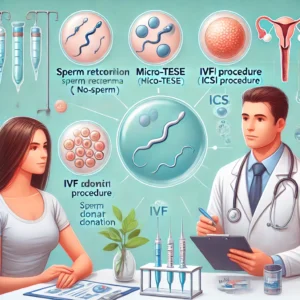
My sperm count is zero how to increase
My Sperm Count is Zero – How to Increase It? Having a zero sperm count, also known as azoospermia, can be a distressing condition for

Non-obstructive azoospermia (NOA) is a condition where sperm is absent in semen due to poor or no sperm production. It is a leading cause of male infertility and can be distressing for couples trying to conceive. Many men wonder: Is nonobstructive azoospermia curable? The answer depends on the underlying cause, but medical advancements offer various treatment options to help affected individuals.
Non-obstructive azoospermia occurs when the testicles fail to produce enough sperm due to genetic issues, hormonal imbalances, or testicular damage. Unlike obstructive azoospermia, where sperm is blocked from release, NOA results from impaired sperm production itself.
While a complete cure is not always possible, some cases of NOA can be treated successfully. The possibility of treatment depends on the underlying cause and whether the testicles still have some sperm-producing potential.
Most men with NOA do not experience noticeable symptoms except for infertility. However, some signs may include:
Several factors can lead to NOA, including:
Doctors use various tests to diagnose NOA, such as:
If some sperm are being produced, Micro-TESE (Microsurgical Testicular Sperm Extraction) can retrieve sperm directly from the testicles for use in Intracytoplasmic Sperm Injection (ICSI) during IVF.
New research is exploring treatments like stem cell therapy and gene editing to restore sperm production, but these are not yet widely available. If traditional treatments fail, options like donor sperm or adoption provide alternatives for starting a family.

My Sperm Count is Zero – How to Increase It? Having a zero sperm count, also known as azoospermia, can be a distressing condition for

My Husband Has No Sperm – How Can I Get Pregnant? My husband has no sperm – how can I get pregnant? Discovering that your

Prolistem, a patented formula, has not been evaluated by the Food and Drug Administration. This product is not intended to diagnose, treat, cure, or prevent any disease.
Copyright © 2025 Prolistem®
Prolistem, a patented formula, has not been evaluated by the Food and Drug Administration. This product is not intended to diagnose, treat, cure, or prevent any disease.
Copyright © 2023 Prolistem®